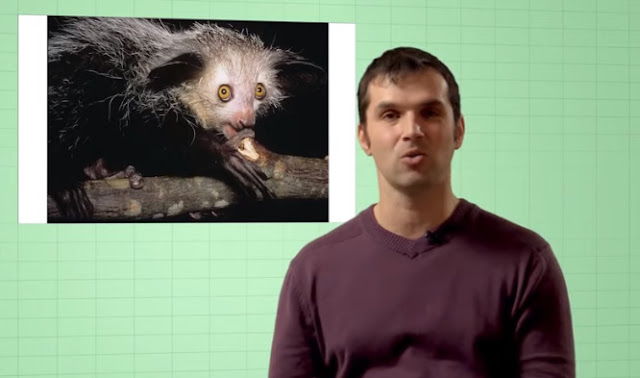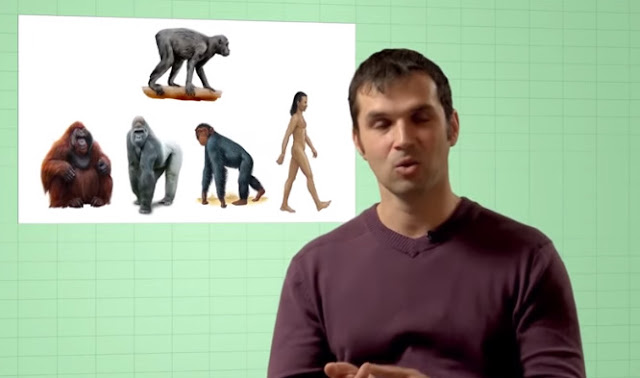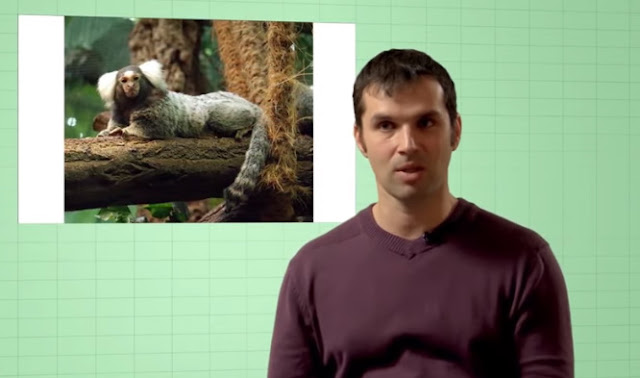Given the same external pressures maybe they could evolve into a similar type of upright walking human shape. Parallel Evolution, 5 types of Crab shaped animals evolved and include the Crab.... All are unrelated but evolution found the same or similar answer independently of each other.
Let’s continue talking about the various myths of human evolution. I have deliberately not dealt this myth yet because it has already been addressed by many reputed scientists.
I will now say few words about, but will do so in my own way, trying not to repeat what others had already said. I’ve just attended a Science Festival in Moscow where I’ve heard the question like Why aren’t apes evolving into humans? posed – at least three times.
Surprisingly, it was posed by well-educated people. the whole theory of evolution has been compressed into this single phrase. Accordingly, if we take this phrase literally, then we should be able to go to the zoo and look at monkeys jumping to their feet, shedding their tails and hair, and turning into handsome lads or lasses – depending on their bi ological sex.
Well, not quite. The truth is: this phrase is a major simplification. For instance, it doesn’t explain what particular kind of apes had “evolved into humans”. So, if someone tells you that apes are not turning into humans, you should ask: what apes do you mean?
There are more than 400 species of primates currently living on our planet, none of which is our ancestral species. By the way, it’s interesting how mass culture works here. There is a scene where one protagonist, Terry, asks another one, Larry: “Who’s evolved? Who’s evolved?” Of course, they are primates, but they are only very remotely related to us, our lineages having separated more than 30 million years ago.
Of course, if we are going to speak of anyone at all in his context, it should at most be the great apes, and primarily the chimpanzee, our closest relative in terms of constitution, genetics, and biochemistry. But chimps also are not our ancestors. If we look at our distant quadruped ancestor who lived, the proconsul –here he is on the picture – who lived about 15 million years ago and compare him with a human, we will see that our two species are quite different.
But the proconsul is also ancestral to other great apes, namely chimpanzees, gorillas, and orangutans – but does not resemble any of them. Furthermore, they do not resemble each other. For instance, in the course of evolution our ancestors’ legs had been lengthening in relation to their arms. But for chimp ancestors of chimps it was the other way around:
their arms had been lengthening in relation to their legs. Our cupids had been shortening (and we are proud of that), but chimp cupids, and, generally, their teeth and jaws were growing bigger. One of the features which is often considered quintessentially human is concealed ovulation. That is, our women do not show external signs of ovulation and, looking at a woman, one cannot tell the phase of her menstrual cycle. But looking at a female chimpanzee uninformed people sometimes ask: “Does she have a disease? What is that swelling?”
She gets a swelling that looks something like a red football. In fact, that is a swelling the chimp’s genital skin. When she is ovulating and is ready for mating, she uses it to signal to the male that she is ready and available. But if we look at female gorillas or orangutans, we won’t see any such external signs of ovulation.
It must be a specific feature of chimpanzees which has emerged in the course of their evolution. So here is what I am trying to say: while our ancestors were evolving into humans, the chimpanzee ancestors were also not sitting idle. They were turning into chimpanzees. And in order for chimps to suddenly turn into humans…Well, “suddenly” does not work because this has taken millions of years. But in any case, the chimp would first have to rewind its evolution by about 10 million years in order to return to its primitive ancestral form.
But this is impossible. Besides, neither chimps, nor other apes actually need to do that. There is truth to the joke that apes are not evolving into humans because they are afraid that they will be forced to work. In other, if chimp evolution continues, it will not move towards humanity, but rather in the direction of an “ultra-chimpanzee.” Although, unfortunately, the more likely forecast for modern hominids is extinction, given how much we humans are contributing to their disappearance.
There is one more interesting point to make. Comparing a human with other primates we view ourselves as an ultimate example of progress. But if we look closer at other simians, we will see that, in many ways, we are the ones who are behind in our evolution. Traditionally, the following features are described as quintessentially human: a huge brain – for a human – bipedalism, and, for instance, the ability to chuck spears at elephants. But there are also other features, no less important

For example, in the course of evolution our stomatognathic system has been reducing and this is considered to be a progressive feature. This has led to the fact that our third molars or wisdom teeth which can erupt late in life, or not at all.
But callitrichids – those are very cure monkeys from South America – never have wisdom teeth. Their third molars disappeared completely. We also consider our reduced cupids to be an advanced feature. But the aye-ayes – lemurs native to Madagascar –have no cupids at all. In that sense, they have left humans far behind.
By the way: our science editor Stanislaw Drobyshevsky has recently published a Russian-language book titled “Non-Missing Link” which describes plenty of monkey peculiarity like this and which I strongly recommend. Another example: our ears are small and immobile. This feature too is considered to be evolutionary advanced. But, if we look at an adult gorilla or an adult orangutan, we won’t find – what? External ears. They are so small and rudimental that one usually cannot see them in the animals’ thick fur.
Thus, in terms of reduction of ear dimensions gorillas and orangutans are far ahead of us. Such examples are very numerous. In sum, who is the faster evolver – our simian relatives, or us – is an open question. Because, as you can see, in many ways, human actually resemble living fossils.




Comments
Post a Comment